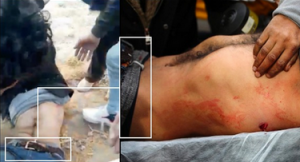On May 8, the prominent German magazine Der Spiegel published an article arguing that Greek security forces shot dead a Pakistani illegal immigrant who was trying to enter the country from Turkey. The article was based on the findings of Nick Waters, a former British officer working for the investigative site Bellingcat.
Over 100 Members of the European Parliament (MEPs) are now requesting that there be an official investigation into the incident and that Greece be sanctioned if proved responsible.
But how accurate is the article? Not as accurate as some would hope. Buttressed with weak evidence and ambiguities, it tries to incriminate the Greek security forces.
Savvas Vlassis, a defense journalist, editor-in-chief of Doureios Ippos magazine, and a former Hellenic Army paratrooper, has written a rebuttal to Spiegel’s and Bellingcat’s investigation. The results are revealing.
Before we delve into the rebuttal, some context is necessary in order to better understand the situation and appreciate the geopolitical nuances.
For years now, Greece and several other of the European Union’s (EU) border-nations have been on the receiving end of an unprecedented wave of displaced people, partly the result of the Syrian civil war. Millions of them have illegally entered the borders of the EU. Throughout this struggle, the EU has been characteristically inconsistent and indecisive in its support of its own member-states — an attitude reminiscent of the economic crisis that rocked the Union a few years ago. Furthermore, several international and European left-leaning non-governmental organizations have been accusing the border-states of taking illegal measures to protect their own borders.
Turkey, meanwhile, has taken advantage of the situation and weaponized the refugees for its own international and regional benefits. In February, the Turkish President Tayyip Erdogan announced that his country would no longer stop refugees from trying to illegally enter Greece and Europe, thus unilaterally negating signed agreements between Turkey and the EU. But he did more than that: In what amounts to a textbook asymmetrical warfare attack, Turkish military, paramilitary, and law enforcement personnel directly supported the attempts of thousands of refugees to cross the Greek border. The Turkish forces attacked and disrupted the Greek and European defenses. It’s worth noting that Turkey, like Greece, is a NATO member.
The following article was originally published in Greek on Doureios Ippos on May 9.
Air France announces first flight to Athens on May 23
Τhe May 8 report of the German magazine Der Spiegel suggests that the Pakistani, Muhammad Gulzar, was mortally wounded on March 4, 2020, in Pazarkule, Turkey. The report, which is based on an investigation by former British Army officer Nick Waters, who is working for the investigative site Bellingcat, states that Gulzar was killed by a 5.56mm bullet.
According to the Der Spiegel article, video footage “demonstrate[s] that Greek security forces likely used live rounds on 4 March 2020 against refugees and migrants trying to break through the Turkish-Greek border fence. We identified seven people who were wounded over a period of about 40 minutes, one of whom later died. His name was Muhammed Gulzar”.
Using video footage, the investigative team argues that a man was allegedly wounded at about 1027 (Eastern European Time). Then, at approximately 1030, a second person, Gulzar, was also wounded. The investigative team presents pictures from Gulzar’s evacuation to buttress its claims.
However, in the presented video footage, no shots can be heard during Gulzar’s alleged wounding or subsequent evacuation.
In order to circumvent this weak point, the investigative team tries to determine if any live shots were fired on that day and from which side of the border. To prove the first point, they present an audio forensic analysis of video footage in which successive shots are heard, shots that, according to an expert who helped the investigators, are clearly from live ammunition and not blanks. Based on the expert’s opinion that the rounds were fired from a distance of 40-60 meters away from the point that the camera was standing, the investigators present a scene that seems to show a team of Greek soldiers 50 meters away. So they conclude that “it is highly probable that shots were fired from the Greek side.”
Archaeological sites to open on May 18 (watch video)
“Highly probable.” They are not sure.
But there is absolutely no picture or video of Greek security personnel firing directly against anybody on that particular day. It is probable that in fact live ammunition rounds were fired by the Greek troops but in the air as warning shots — this is a standard, non-violent operating procedure used to stop illegal entries.
All of the above, regardless of the veracity of the investigative team’s claims, cannot be considered concrete proof that Gulzar, and the first alleged victim, were shot from the Greek side of the border. The investigators claim that they received testimonies from illegal immigrants about Greek live fire. In the video, in which shots can be heard, the illegal immigrants are running away and as the investigators comment, “The migrants themselves appear to believe they were shot at from the Greek side of the border.”
“Appear to believe.”
At this point, it is worth highlighting that the video in which shots can be heard was recorded at 1057 — this is about 25 minutes after the alleged wounding of Gulzar, as the investigators point out. With a cursory viewing of the Bellingcat’s video, this clarification can easily be missed, and the viewer can form the erroneous impression that the video depicts the moment of Gulzar’s wounding. Nick Waters’s Twitter post is also misleading: In his post, he presents only the video with the shots that were recorded at about 1057.
Read more: sofrep
Ask me anything
Explore related questions





